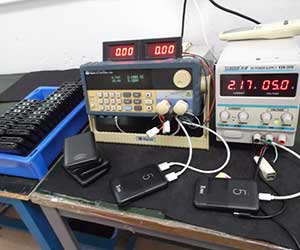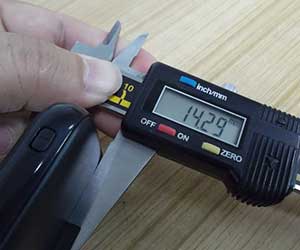Power bank
Technical specifications:
-Size: 63.5*14.5*95.5mm
-Color: Black
-Material: ABS Fireproof
-Battery capacity: 5000mAh
-Battery specification: 115570, grade A quality
-Cell protection mode: overload, over-discharge, overcharge, short circuit, etc.
-Dual USB output: 5V±0.3V, 2100mA(max)
-Input: 5.0V±5%
-Support automatic identification output
-Charge and discharge cycles ≥ 300 times
-Working temperature: Charging temperature: 0°C-45°C
-Discharging temperature: -20°C-55°C
-The side of the product has two USB ports + 1 MICRO USB charging port
-Housing with a non-slip design
-Accessories: Micro USB charging cable with a length of 0.26M
-The product has electrostatic protection, input/output overvoltage protection, intelligent output identification, input/output overcurrent protection, short circuit protection, charging time protection, abnormal temperature protection, battery overcurrent protection, and output
anti-flood protection.
Keep reading to learn more about choosing a great power bank for maximum efficiency!
What is a power bank?
A power bank is a portable device used to store energy, usually lithium-ion batteries. It charges electronic devices such as smartphones, tablets, and laptops when there is no access to a power outlet. Power banks benefit people who are always on the go and must keep their devices charged. Various sizes and capacities are available, allowing users to choose the right one for their needs. With the increasing use of mobile devices, power banks have become an essential accessory for many people.
mAh, or milliamp hours, is a measure of electrical charge that affects the output and performance of your portable device and charger. If you’ve ever had trouble understanding why specific chargers work better than others or why laptop batteries tend to be so long-lasting compared to cell phone batteries, mAh may have something to do with it. This blog post explains what mAh in a power bank means and how it can affect your charging experience.
What Is mAh in portable chargers?
mAh, a system of units, measures a power bank’s or any other device’s capacity. Hence, every device that generates electricity has a mAh specification. Milliampere hours (mAh) are a unit of measurement used to describe the amount of battery capacity required to provide the flow of one milliampere of electrical current for one hour. Therefore, a power bank’s ability increases with its mAh.
Power banks with low capacities typically range from 1,000 to 5,000 mAh. These smaller, more portable power supplies would be ideal if you only sometimes boost power.
Power banks with a medium capacity range from 7,000 to 10,000 mAh. Finding a wall charger could take some time if you frequently rely on your phone when travelling. This selection of power banks could be ideal for you. A high-capacity power bank should be your pick if you require a bigger-capacity power source for longer.
Heavy-capacity power banks might be a perfect choice as they can supply the most power. However, the more powerful a power bank is, the longer it takes to charge and is bulkier.
How to choose the capacity of your portable power bank?
Low-capacity power banks
5,000 mAh power bank
Given that most individuals don’t leave home with a dead phone, a 5,000 mAh power bank should be sufficient to ensure that your phone lasts well over a day.
These portable power banks are popular among phone users for a good reason—they offer enough capacity. They are also relatively lightweight and easy to carry.
Medium-capacity power banks
7,000 mAh power bank
A medium-capacity power bank is a perfect choice if you’re travelling to locations where you frequently use your phone, and it might take some time before you find a wall charger. The 7,000 mAh power banks can charge multiple small gadgets, including headphones and your phone.
Heavy-capacity power banks
20,000+ mAh power bank
Over 20,000 mAh power banks are typically for camping or vacation because they can charge your portable electronics for a day.
After reading the above content, you should already know what mAh is. It would help if you were okay with choosing a power bank because many options will meet your demands.
What’s a good amount of mAh for a portable charger?
Your phone should last more than a day with a 5,000 mAh power bank. And the range of between 7,000–10,000 mAh is a great choice for phone users with specific needs or situations.
Is higher mAh better for the portable charger?
Not necessarily. The 10,000 mAh power banks are more expensive than those with a capacity of 5,000 mAh. Higher mAh also indicates it has more power, which means it weighs more and has larger designs that are frequently inconvenient to carry.
Why are power banks not allowed in checked bags on planes?
Power banks are becoming increasingly popular as a convenient way to charge our smartphones on the go. However, when it comes to air travel, power banks are not allowed in checked bags due to safety concerns. It is because power banks can overheat and cause a fire in the cargo hold of an aeroplane, which could be dangerous for both passengers and crew members. The lithium-ion batteries that power banks use can also pose a risk of explosion during flight. To ensure passenger safety, airlines have strict rules regarding the transportation of power banks in checked bags.
Power banks are an accessory worth having! You’ll want a power bank if you have a smartphone or other electronics to keep charged.
















